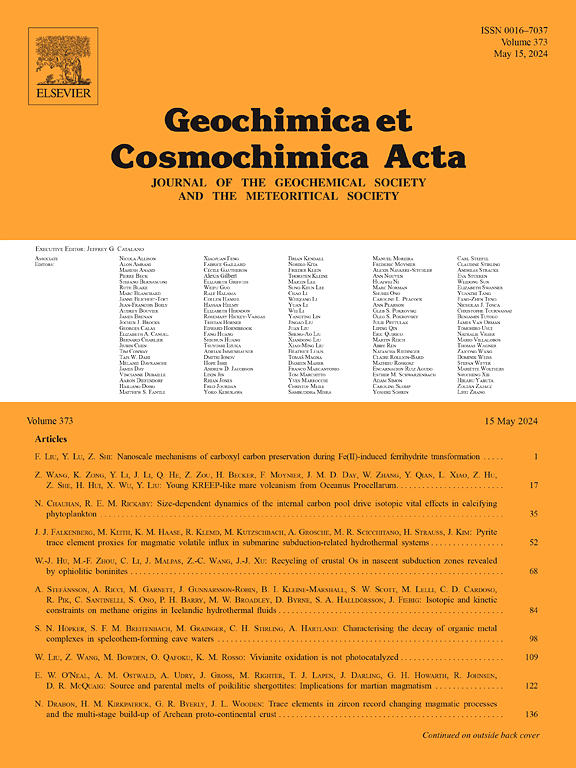Oxygen isotope fractionation during amorphous to crystalline calcium carbonate transformation at varying relative humidity and temperature
IF 4.5
1区 地球科学
Q1 GEOCHEMISTRY & GEOPHYSICS
引用次数: 0
Abstract
Crystalline calcium carbonate isotope compositions have been widely used to reconstruct past environments. However, if their isotopic compositions are modified because of crystallization from an amorphous precursor, their reliability as paleo-geochemical proxies can be compromised. This study explored the changes in the oxygen isotope compositions during the transformation of amorphous calcium carbonate (ACC) into crystalline carbonate under different conditions of relative humidity (RH of 33–95 %), temperature (T of 5 °C and 20 °C) and in the presence/absence of atmospheric CO2. The data showed that at low RH and T (e.g., RH ≤ 45 % and 5 °C) when a complete ACC-crystalline carbonate transformation did not take place then the original ACC δ18O values (δ18OCaCO3 = −15.9 ± 1.0 ‰, VPDB) were preserved throughout the experimental runtime (up to 144 days). In contrast, in fully crystallized CaCO3 (e.g., at RH ≥ 60 %) the δ18OCaCO3 values increased rapidly over the first few days, followed by a slower and gradual increase. By the end of the experiments (i.e., after 103–144 days) the crystalline δ18OCaCO3 values ranged from −10.4 ‰ to −8.1 ‰ in the presence of atmospheric CO2 and from −12.6 ‰ to −9.5 ‰ in the CO2-free experiments. These changes in oxygen isotope compositions of the CaCO3 reaction products (calcite and/or vaterite) were mainly driven by exchange with H2O from the hydrated ACC i.e. the synthesis fluid. In CO2-present experiments, oxygen isotope fractionation factors between the CaCO3 reaction products and the synthesis fluid (18αc–w) approached or exceeded oxygen isotope equilibrium values. This could be explained by a decrease in the initially high pH of the aqueous fluid released from ACC dissolution during CO2 hydration/hydroxylation, which would have increased the oxygen isotope exchange kinetics between H2O and dissolved inorganic carbon (DIC). In some experiments, the hydration/hydroxylation of 18O-enriched CO2, due to isotopic salt-effects, might have also resulted in 18O-enriched calcium carbonates and calculated fractionation factors that exceeded equilibrium values. In the CO2-free experiments, isotopic equilibrium between the crystalline phase and the synthesis fluid was not reached. This oxygen isotope disequilibrium suggests that without the pH lowering effect of the hydroxylation/hydration of CO2, the CO32− released during ACC/calcite dissolution-reprecipitation may have not isotopically equilibrated with the high pH synthesis fluid due to the long equilibration times required to reach isotope equilibrium at high pH values, leading to the self-buffering of δ18OCaCO3 values. The results suggest that the oxygen isotopic compositions of natural carbonates formed from ACC transformation in air and at low water/solid ratio (e.g., biominerals or carbonates formed in caves) are complex and cannot be used as simple proxies if the reaction kinetics (RH/CO2/T) and H2O sources are not known and quantified.
在不同相对湿度和温度条件下无定形碳酸钙向结晶碳酸钙转变过程中的氧同位素分馏
晶体碳酸钙同位素组成已被广泛用于重建过去的环境。然而,如果它们的同位素组成因无定形前体结晶而发生变化,那么它们作为古地球化学代用指标的可靠性就会受到影响。本研究探讨了无定形碳酸钙(ACC)在相对湿度(RH,33-95%)、温度(T,5 °C和20 °C)以及大气中是否存在二氧化碳等不同条件下转变为结晶碳酸盐过程中氧同位素组成的变化。数据显示,在低相对湿度和低温度条件下(如相对湿度≤ 45 %和 5 °C),当 ACC 未完全转化为碳酸盐晶体时,原始 ACC δ18O 值(δ18OCaCO3 = -15.9 ± 1.0 ‰,VPDB)在整个实验过程中(长达 144 天)都得以保留。相反,在完全结晶的 CaCO3 中(例如相对湿度≥ 60%),δ18OCaCO3 值在最初几天迅速增加,随后逐渐缓慢增加。到实验结束时(即 103-144 天后),在有大气二氧化碳存在的情况下,晶体的 δ18OCaCO3 值从-10.4‰到-8.1‰不等,而在无二氧化碳实验中,晶体的 δ18OCaCO3 值从-12.6‰到-9.5‰不等。CaCO3 反应产物(方解石和/或水帘石)氧同位素组成的这些变化主要是由与水合 ACC(即合成液)中的 H2O 交换引起的。在二氧化碳存在的实验中,CaCO3 反应产物与合成液之间的氧同位素分馏系数(18αc-w)接近或超过氧同位素平衡值。这可能是由于二氧化碳水合/羟基化过程中 ACC 溶解释放的水液 pH 值降低,从而增加了 H2O 和溶解无机碳 (DIC) 之间的氧同位素交换动力学。在某些实验中,由于同位素盐效应,富含 18O 的 CO2 水合/羟基化还可能导致富含 18O 的碳酸钙和计算出的分馏系数超过平衡值。在不含二氧化碳的实验中,结晶相与合成液之间没有达到同位素平衡。这种氧同位素不平衡表明,如果没有 CO2 羟基化/水化的 pH 值降低效应,在 ACC/方解石溶解-重沉淀过程中释放的 CO32- 可能没有与高 pH 值合成液达到同位素平衡,因为在高 pH 值下达到同位素平衡需要较长的平衡时间,从而导致 δ18OCaCO3 值的自我缓冲。研究结果表明,在空气中和低水固比条件下(如洞穴中形成的生物矿物或碳酸盐),由 ACC 转化形成的天然碳酸盐的氧同位素组成非常复杂,如果不知道反应动力学(相对湿度/CO2/T)和 H2O 的来源并对其进行量化,就不能将其用作简单的代用指标。
本文章由计算机程序翻译,如有差异,请以英文原文为准。
求助全文
约1分钟内获得全文
求助全文
来源期刊

Geochimica et Cosmochimica Acta
地学-地球化学与地球物理
CiteScore
9.60
自引率
14.00%
发文量
437
审稿时长
6 months
期刊介绍:
Geochimica et Cosmochimica Acta publishes research papers in a wide range of subjects in terrestrial geochemistry, meteoritics, and planetary geochemistry. The scope of the journal includes:
1). Physical chemistry of gases, aqueous solutions, glasses, and crystalline solids
2). Igneous and metamorphic petrology
3). Chemical processes in the atmosphere, hydrosphere, biosphere, and lithosphere of the Earth
4). Organic geochemistry
5). Isotope geochemistry
6). Meteoritics and meteorite impacts
7). Lunar science; and
8). Planetary geochemistry.
 求助内容:
求助内容: 应助结果提醒方式:
应助结果提醒方式:


